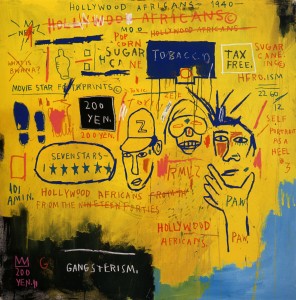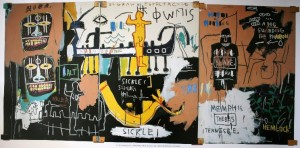When Graffiti is situated within the sphere of mainstream art, it is evacuated of its subversive content. It becomes tame: a phenomenon that by its nature defies commodification becomes just another piece of property. Basquiat paradoxically is the embodiment and the critique of this very process. Jean-Michel Basquiat was associated with the Graffiti movement. The problem is that critics subsume him in it, thereby positioning any interrogation of Basquiat’s art work within a primitivist framework, where, among other things, “the critics and reviewers of his day cited his apparent drug addictions and ‘street origins’ as license to handle him and his oeuvre in a decidedly exoticized, sensationalist manner” (Rodrigues, 229).

Jean-Michel Basquiat, Hollywood Africans, 1983. Synthetic polymer and mixed media on canvas, 84 × 84 in. (213.4 × 213.4 cm). Whitney Museum of American Art, New York; gift of Douglas S. Cramer 84.23
Basquiat played with these primitivist associations. The story goes Basquiat showed up to gallery openings in a paint splattered Armani suite, complete with a straw hat. The reference to slavery is clear enough here. Even his early tag, SAMO, bears a marked resemblance to the racial slur ‘sambo’. His later work would play with his perceived peripheral status even more. The above painting, Hollywood Africans presents a satire of African American’s representation in mainstream media. The phrases emblazoned upon the canvas “BWANA” (the swahili word for master), “SUGAR CANE”, “TOBACCO” and “GANSTERISM” speak of the various motifs, symbols and epithets framing the depiction of African Americans in Hollywood. Black Americans are deprived of subjectivity, positioned instead as pre-packaged commodities available for consumption.

Jean-Michel Basquiat, Untitled (History of the Black People) (1983).Acrylic paint and oil paint stick on panel. Estate of Jean-Michel Basquiat.
It is this commodity culture, industrial capitalism, that has served to mark and consequently victimize the black body. It is this commodity culture, that, in spite of his mixed race heritage (Basquiat was half Puerto Rican and half Haitian), and middle class status, identifies Basquiat as a member of a population whose hallmark is marginality. Basquiat did not need to come from the projects to be associated with them. As Laurie Rodrigues explains,
Through omissions, contradictions, and even through the way artists, black and white alike, populated their works with black bodies and signs, a black presence was crucial to America’s need for a sense of cultural and intellectual superiority. The representation of the black subject and the role of the black artist have historically functioned to conceal reality and separate the subjugated group from the dominant culture: the categories and designated ‘places’ in which black artists are meant to remain function to conceal the reality of black subjectivity (Rodrigues, 235).
The place of the black artist must be managed –routinized even – in order to ensure his position of subservience in relation to the dominant cultural paradigm. The subjugated group is situated on the periphery even if the artist himself is not. Basquiat, his work, and his connection to graffiti, is framed in terms of its relationship to the urban landscape produced by Robert Moses. The systemic racism, and structural conditions that gave birth to that landscape are represented in much of Basquiat’s artistic production. Yet latent within his work, there is also a profound sense of irony. The implicit critique of commodity culture that seems to permeate Basquiat’s entire oeuvre is itself a commodity. Basquiat’s work is marked by this fraught, but also productive, ambiguity. His contemporary critics who would frame him in solely in terms of his relationship to graffiti and primitivism miss this crucial point, and in so doing, play directly into his hands. Before anything else, Basquiat’s artistic production was self reflexive.

Very superb visual appeal on this web site, I’d rate it 10 10.
Hello my friend! I want to say that this article is amazing, nice written and include almost all vital infos. I would like to see more posts like this .
I do like the way you have framed this particular situation plus it does give us some fodder for consideration. Nonetheless, from what I have witnessed, I just simply trust when the actual opinions pile on that people remain on issue and don’t embark on a soap box of the news of the day. Still, thank you for this fantastic piece and whilst I can not really agree with it in totality, I value the perspective.
Very good written post. It will be useful to everyone who usess it, including myself. Keep up the good work – looking forward to more posts.
Hi there! Do you know if they make any plugins to help with SEO?
I’m trying to get my blog to rank for some targeted keywords but I’m not seeing very good results.
If you know of any please share. Many thanks!